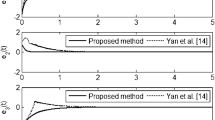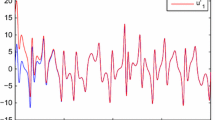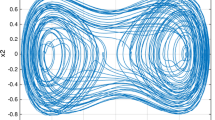Abstract
In this paper, the synchronization problem is investigated for two single-degree-of-freedom oscillators via neural network based on fixed-time terminal sliding mode control. First, a fixed-time terminal sliding mode is constructed. Then, in order to deal with the unknown function in master system, the neural network technique is introduced. Combining fixed-time terminal sliding mode surface and adaptive control scheme plus neural network technique, an adaptive fixed-time terminal sliding mode controller is presented. The stability of the closed-loop system is analyzed. Finally, simulation results are provided to demonstrate the effectiveness of the proposed two control strategies.





Similar content being viewed by others
References
Chung SJ, Slotine JJE (2009) Cooperative robot control and concurrent synchronization of Lagrangian systems. IEEE Trans Rob 25(3):686–700
Du HB, Li SH (2014) Attitude synchronization control for a group of flexible spacecraft. Automatica 50(2):646–651
Zhang Z, Shen H, Li J (2011) Adaptive stabilization of uncertain unified chaotic systems with nonlinear input. Appl Math Comput 218(8):4260–4267
Jia Q (2007) Adaptive control and synchronization of a new hyperchaotic system with unknown parameters. Phys Lett A 362(5–6):424–429
Li R, Xu W, Li S (2009) Anti-synchronization on autonomous and non-autonomous chaotic systems via adaptive feedback control. Chaos Solitons Fractals 40(3):1288–1296
Li HQ, Liao XF, Li CD, Li CJ (2011) Chaos control and synchronization via a novel chatter free sliding mode control strategy. Neurocomputing 74(17):3212–3222
Li HQ, Liao XF, Chen G, Hill DJ, Dong ZY, Huang TW (2015) Event-triggered asynchronous intermittent communication strategy for synchronization in complex dynamical networks. Neural Netw 66:1–10
Li CJ, Gao DY, Liu C, Chen G (2014) Impulsive control for synchronizing delayed discrete complex networks with switching topology. Neural Comput Appl 24(1):59–68
Li CJ, Yu XH, Huang TW, He X (2017) Distributed optimal consensus over resource allocation network and its application to dynamical economic dispatch. IEEE Trans Neural Netw Learn Syst. https://doi.org/10.1109/TNNLS.2017.2691760
Li CJ, Yu XH, Yu WW, Huang TW, Liu ZW (2016) Distributed event-triggered scheme for economic dispatch in smart grids. IEEE Trans Ind Inf 12(5):1775–1785
Lei Y, Xu W, Shen J, Fang T (2006) Global synchronization of two parametrically excited systems using active control. Chaos Solitons Fractals 28(2):428–436
Wu XF, Cai JP, Wang MH (2008) Global chaos synchronization of the parametrically excited Duffing oscillators by linear state error feedback control. Chaos Solitons Fractals 36(1):121–128
Lei Y, Yung KL, Xu Y (2010) Chaos synchronization and parameter estimation of single-degree-of-freedom oscillators via adaptive control. J Sound Vib 329(8):973–979
Zhang Z, Wang Y, Du Z (2012) Adaptive synchronization of single-degree-of-freedom oscillators with unknown parameters. Appl Math Comput 218(12):6833–6840
Yan JJ, Hung ML, Liao TL (2006) Adaptive sliding mode control for synchronization of chaotic gyros with fully unknown parameters. J Sound Vib 298(1–2):298–306
Yuan J, Shi B, Xiu G (2016) Sliding control for single-degree-of-freedom fractional oscillators. arXiv preprint arXiv:1608.04850
Haibo Du, Xinghuo Yu, Michael Z.Q. Chen, Shihua Li, (2016) Chattering-free discrete-time sliding mode control. Automatica 68:87-91
Du HB, Wen GH, Cheng YY, He YG, Jia RT (2017) Distributed finite-time cooperative control of multiple high-order nonholonomic mobile robots. IEEE Trans Neural Netw Learn Syst 28(12):2998–3006
Du HB, Wen GH, Yu XH, Li SH, Chen MZQ (2015) Finite-time consensus of multiple nonholonomic chained-form systems based on recursive distributed observer. Automatica 62(12):236–242
Du HB, He YG, Cheng YY (2014) Finite-time synchronization of a class of second-order nonlinear multi-agent systems using output feedback control. IEEE Trans Circuits Syst I Regul Pap 61(6):1778–1788
Sun H, Hou L, Zong G (2016) Continuous finite time control for static var compensator with mismatched disturbances. Nonlinear Dyn 85(4):2159–2169
Aghababa MP, Khanmohammadi S, Alizadeh G (2011) Finite-time synchronization of two different chaotic systems with unknown parameters via sliding mode technique. Appl Math Model 35(6):3080–3091
Li S, Tian YP (2003) Finite time synchronization of chaotic systems. Chaos Solitons Fractals 15(2):303–310
Filippov AF (1988) Differential equations with discontinuous right-hand sides. Kluwer Academic, New York
Polyakov A (2012) Nonlinear feedback design for fixed-time stabilization of linear control systems. IEEE Trans Autom Control 57(8):2106–2110
Zuo ZY (2015) Non-singular fixed-time terminal sliding mode control of non-linear systems. IET Control Theory Appl 9(4):545–552
Ni JK, Liu L, Liu CX, Hu XY, Li SL (2017) Fast fixed-time nonsingular terminal sliding mode control and its application to chaos suppression in power system. IEEE Trans Circuits Syst II Express Briefs 64(2):151–155
Park J, Sandberg IW (1991) Universal approximation using radial-basis-function networks. Neural Comput 3(2):246–257
Sanner RM, Slotine JJ (1992) Gaussian networks for direct adaptive control. IEEE Trans Neural Netw 3(6):837–863
Sun H, Guo L (2017) Neural network-based DOBC for a class of nonlinear systems with unmatched disturbances. IEEE Trans Neural Netw Learn Syst 28(2):482–489
Li CJ, Yu XH, Huang TW, Chen G, He X (2016) A generalized Hopfield network for nonsmooth constrained convex optimization: Lie derivative approach. IEEE Trans Neural Netw Learn Syst 27(2):308–321
Bhat SP, Bernstein DS (1995) Lyapunov analysis of finite-time differential equations. In: Proceedings of the American control conference, 1831–1832
Bhat SP, Bernstein DS (1998) Continuous finite-time stabilization of the translational and rotational double integrators. IEEE Trans Autom Control 43(5):678–682
Feng Y, Yu X, Man Z (2002) Non-singular terminal sliding mode control of rigid manipulators. Automatica 28(11):2159–2167
Sun HB, Li SH, Sun CY (2013) Finite time integral sliding mode control of hypersonic vehicles. Nonlinear Dyn 73(1–2):229–244
Li YK, Sun HB, Zong GD, Hou LL (2017) Composite anti-disturbance resilient control for Markovian jump nonlinear systems with partly unknown transition probabilities and multiple disturbances. Int J Robust Nonlinear Control 27(14):2323–2337
Xu B, Sun FC (2018) Composite intelligent learning control of strict feedback systems with disturbance. IEEE Trans Cybern 48(2):730–741
Sun HB, Li YK, Zong GD, Hou LL (2018) Disturbance attenuation and rejection for stochastic Markovian jump system with partially known transition probabilities. Automatica 89:349–357
Acknowledgements
This work was supported in part by the National natural Science Foundation of China (Nos. 61773236, 61773235), and the Postdoctoral Science Foundation of China (2017M612236, 2017M611222).
Author information
Authors and Affiliations
Corresponding author
Ethics declarations
Conflict of interest
The authors declare that they have no conflict of interests.
Rights and permissions
About this article
Cite this article
Sun, H., Hou, L. & Li, C. Synchronization of single-degree-of-freedom oscillators via neural network based on fixed-time terminal sliding mode control scheme. Neural Comput & Applic 31, 6365–6372 (2019). https://doi.org/10.1007/s00521-018-3445-x
Received:
Accepted:
Published:
Issue Date:
DOI: https://doi.org/10.1007/s00521-018-3445-x




